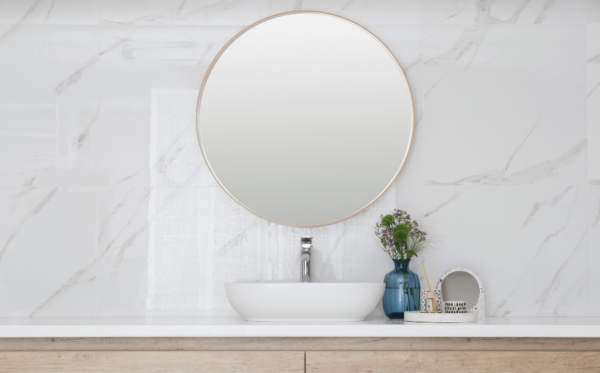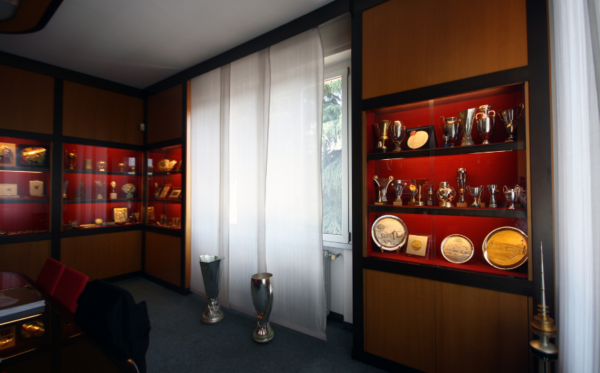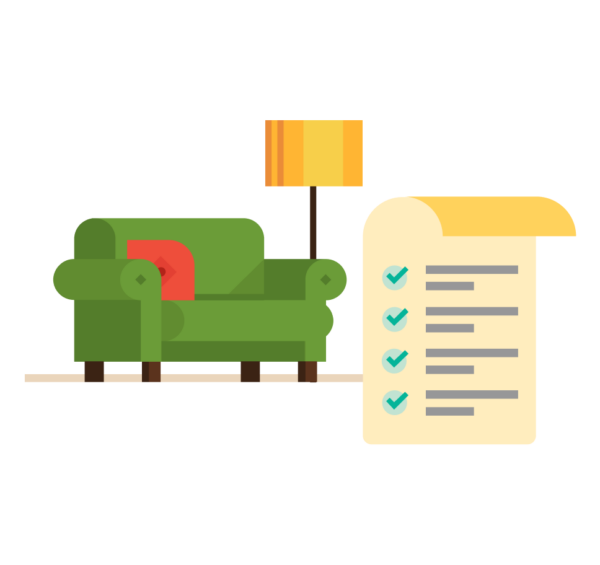Our goal is to give you the tools and confidence you need to improve your finances. Although we receive compensation from our partner lenders, whom we will always identify, all opinions are our own. Credible Operations, Inc. NMLS # 1681276, is referred to here as "Credible."
Refreshing a room in your house can totally change the feel and functionality of your space. And who doesn’t love coming home to something new?
Designing a room may feel overwhelming at first, but it can also be a lot of fun. Let’s break the process down into a few simple steps you can accomplish yourself.
Here are 13 easy steps to design your room like a professional:
- Set a budget
- Get some inspiration
- Pick a style, theme, or mood
- Choose a color palette
- Decide what functionalities you need
- Measure your space
- Carefully select your anchor purchase
- Create a layout
- Make a purchasing plan
- Order samples
- Pick out accessories
- Don’t forget the lighting
- Add a personal touch
1. Set a budget

Maybe you’ve already been setting aside money for months; maybe you just got a bonus. Maybe you’re willing to tap your home equity so that you can fund the renovation and have your dream space sooner rather than later.
Whatever the case, get the number-crunching step out of the way first. Once you know how much you can spend, you can take on the creative steps with confidence.
One way to access your home equity is through a cash-out refinance. Credible makes finding a great deal on a cash-out refinance easy. You can compare multiple lenders and see prequalified rates on our site in as little as three minutes.
Find My Loan
No annoying calls or emails from lenders!
2. Get some inspiration

DIY designers love using Pinterest for a reason: It puts thousands of images in one place and lets you save them in one click. You can organize those images on your own personal boards, as well as peruse boards other users have created. And, as you save images, Pinterest gets better at suggesting more images you might like.
Home magazines and home improvement shows — which often share their designs on Pinterest — are another great source of inspiration.
At this stage, you’re not trying to find the exact items you want to buy or a specific room you want to copy. You’re just gathering images of aesthetics you like.
Check Out: 10 Ways to Craft an Elegant Outdoor Space
3. Pick a style, theme, or mood

Look over the images you’ve found and see if there’s a common thread among them. Maybe your selection is clean and minimalist, warm and comforting, or reminiscent of your favorite vacation spot. Pick a style, theme, or mood that matches your personality and feels good to your soul.
As inspiring as those perfectly designed rooms you’ve gathered inspiration from can be, they usually reflect someone else’s personality — or no one’s, because they’re meant to be broadly appealing. Now’s the time to think in broad strokes about a space that would really feel like your own.
4. Choose a color palette

Your design will have a more cohesive look if you decide what colors you want to use before you buy or paint anything. Paint stores often have free sample strips or brochures showcasing modern, coordinating colors.
Pinterest also has loads of color palettes other users have created, inspired by nature, seasons, design styles, and locations.
See: 15 DIY Bathroom Remodeling Projects to Tackle This Winter
5. Decide what functionalities you need

In real life, your space can’t just be attractive: It has to be practical and useful, too. Maybe you need more storage space or somewhere to charge electronics. Or stain-resistant upholstery and plenty of light. Make sure to include these functionalities in your plan.
This is also a good time to do some decluttering — only keep what you really need and use. You may not need to buy as many bookcases, for example, if you scale down your library first.
Get Inspired: 8 Popular Pandemic Home Renovations to Transform Your Space
6. Measure your space

There’s nothing worse than finding out your new couch won’t fit through your front door. Make sure to double-measure your space and carefully check the dimensions of items before you order them.
Using masking tape or painter’s tape to mark off the size of furniture and wall decor can help you visualize whether an item is too big or too small before you buy it.
7. Carefully select your anchor purchase

Your anchor purchase is usually the main focus in the room, like a couch in the family room, a vanity in the bathroom, or a headboard in the bedroom. This will be the piece that you plan the rest of your design around.
Knowing its dimensions, colors, and textures will help you narrow your options for the other items you want to buy. Also, do some research to get cost estimates. Knowing what your anchor purchase will cost helps you establish how much you’ll have left for the rest of the room.
8. Create a layout

If you don’t want to learn a new software program, here’s an easy way to plan a layout for your room: search online for free grid paper, customize the square size, then print it out. Decide how much space each square on the grid will represent: perhaps one square foot. Then, pencil in the outline of your room and each element you want to include to see if things will fit where you’d like them to go.
You can use online design software to draw up a plan. Here are two popular (and free) options to consider that run directly in your web browser:
- SketchUp: Lets you model a room in three dimensions. You can also view your 3-D models on your mobile device via the SketchUp Viewer app.
- FloorPlanner: Allows you to make 2-D and 3-D floor plans and has a library of items you can use to lay out your space.
YouTube tutorials are a great way to learn how these programs work.
9. Make a purchasing plan

Now that you know how you want to lay out your space and where everything will fit, you’re ready to make a purchasing plan.
Make one list of items that you already have, and another for items you will need to purchase. Start shopping around, getting real prices, and seeing how your desired purchases work with your budget.
Remember, you don’t have to buy everything at once. You can plan purchases around sales and months when you know your expenses might be lower.
10. Order samples

Paint, window coverings, and flooring are usually easy to get samples of. Upholstered and fabric items, like couches and curtains, may not have samples available unless you’re ordering higher-end or custom items.
Samples are important because seeing an item online or in store is not as useful as seeing it in your own space. That paint color you loved might look too dark or too light in your dining room. Planks of flooring might look too narrow or too wide. Fabric might be too scratchy or too thin.
As much as you can, try before you buy to save money and time. This’ll help ensure you’re happy with the finished product.
11. Pick out accessories

Rugs, throw pillows, curtains, shelves, and art will help pull your space together and make it feel like home. These items are also the perfect way to incorporate the accent colors from your color palette.
If you’re crafty, you might make some of these accessories yourself. If not, Etsy is a great place to find unique items. Local thrift shops, discount stores, estate sales, and garage sales can be good sources of inexpensive items, if you enjoy the thrill of the hunt.
See More Ideas: 18 Home Improvement Projects You Can Wrap Up in a Day
12. Don’t forget the lighting

Light fixtures and lamps add another design element to your room, and lighting plays a key part in setting the mood of your new space. Observe how much natural light your room gets at different times of day, then think about how to supplement it.
You might need light-filtering shades if the daytime sun is too harsh, or strategically placed lamps combined with overhead lighting to read at night.
13. Add a personal touch

Whether it’s family photos, travel mementos, or your trophy collection, adding meaningful items will help your newly designed room feel like your own. Incorporate those keepsakes you have packed away in a box into your new space by framing them or arranging them on a tray or shelf.
How to fund your perfect room
Let’s be real: Having a perfectly designed room, even if you’re doing it yourself, is a luxury. If it’s the only project you’re doing, saving up for it or paying for it one step at a time might be the most cost-effective choice.
However, if designing a room is just one part of a major home renovation you’re planning to borrow for, consider a cash-out refinance. It replaces your existing mortgage with a new, larger mortgage while letting you take out home equity in a lump sum. It can be a good choice if today’s interest rates are lower than your current rate.
Credible can help you compare lenders and find a great rate on a cash-out refinance loan in minutes.


